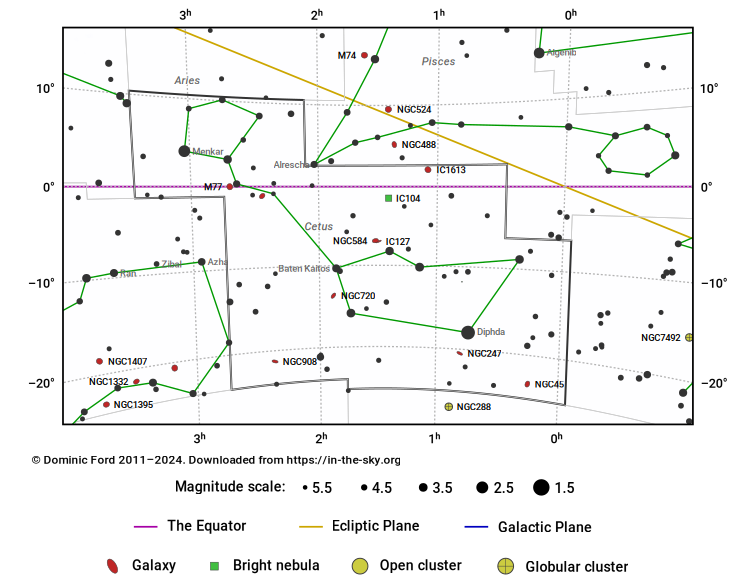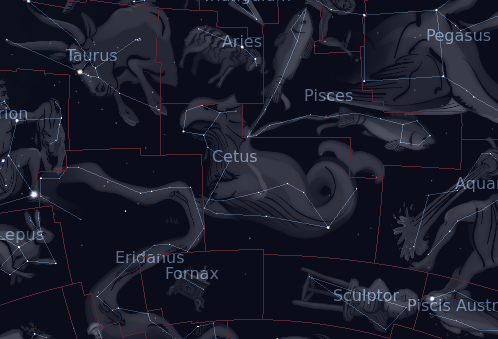The Constellation Cetus
Cetus is the fourth largest constellation, visible in the months around September just to the south of the ecliptic.
Despite its size, Cetus has few bright stars, and because it lies far from the plane of the Milky Way, it also has few deep sky objects. However, it does contain a number of galaxies, including the Messier object M77, a bright spiral galaxy viewed in a face-on orientation.
The star Mira, also known as o-Cet, was the first variable star to be discovered, by David Fabricius in 1596. Its brightness fluctuates between mag 3 and 10 with a 332-day period. Today it is the prototypical example of the Mira class of variable stars.
Cetus is often identified as a whale, or perhaps as the sea monster sent by Poseidon to ravage the kingdom of Cepheus and to which Andromeda was to be sacrificed. The monster was slain by Perseus.
The area of the sky around Cetus is often known as The Sea or the Water, because it contains a number of water-related constellations including Aquarius, Eridanus and Pisces.
Ancient
3.0% of the sky
1231.4 square degrees
Hover the pointer over the name of an object to highlight its position on the starchart to the right, or click to see more information.
| Stars | Open Clusters | Globular Clusters | Galaxies |
| Diphda (mag 2.0) | Messier 77 (mag 8.9) | ||
| Menkar (mag 2.5) | NGC 247 (mag 8.9) | ||
| η-Cet (mag 3.4) | IC 1613 (mag 9.0) | ||
| τ-Cet (mag 3.5) | IC 127 (mag 9.2) | ||
| ι-Cet (mag 3.5) | NGC 720 (mag 10.1) | ||
| γ-Cet (mag 3.6) | NGC 936 (mag 10.2) | ||
| θ-Cet (mag 3.6) | NGC 908 (mag 10.3) | ||
| Baten Kaitos (mag 3.7) | NGC 584 (mag 10.3) | ||
| υ-Cet (mag 4.0) | NGC 45 (mag 10.4) | ||
| δ-Cet (mag 4.1) | NGC 1055 (mag 10.6) | ||
| π-Cet (mag 4.2) | NGC 596 (mag 10.9) | ||
| ξ²-Cet (mag 4.3) | NGC 1087 (mag 11.0) | ||
| μ-Cet (mag 4.3) | NGC 1052 (mag 11.0) | ||
| ξ¹-Cet (mag 4.4) | NGC 1073 (mag 11.1) | ||
| AE Cet (mag 4.5) | NGC 864 (mag 11.1) | ||
| 2-Cet (mag 4.5) | NGC 578 (mag 11.1) | ||
| χ-Cet (mag 4.7) | NGC 210 (mag 11.1) | ||
| λ-Cet (mag 4.7) | NGC 779 (mag 11.2) | ||
| σ-Cet (mag 4.7) | NGC 988 (mag 11.2) | ||
| 20-Cet (mag 4.8) | NGC 1042 (mag 11.2) | ||
| φ¹-Cet (mag 4.8) | NGC 1022 (mag 11.3) | ||
| ε-Cet (mag 4.8) | NGC 636 (mag 11.4) | ||
| κ-Cet (mag 4.9) | NGC 428 (mag 11.5) | ||
| ρ-Cet (mag 4.9) | NGC 533 (mag 11.5) | ||
| ν-Cet (mag 4.9) | NGC 1016 (mag 11.6) | ||
| 56-Cet (mag 4.9) | NGC 151 (mag 11.7) | ||
| 6-Cet (mag 4.9) | NGC 615 (mag 11.7) | ||
| 46-Cet (mag 4.9) | NGC 1032 (mag 11.7) | ||
| 3-Cet (mag 4.9) | NGC 895 (mag 11.8) | ||
| HIP 7999 (mag 5.0) | NGC 521 (mag 11.8) |




